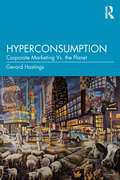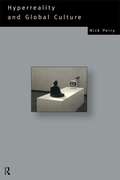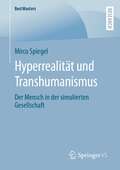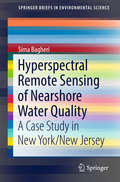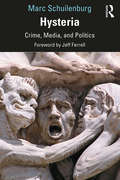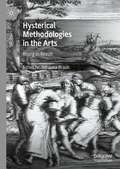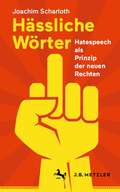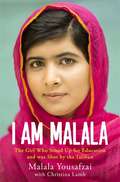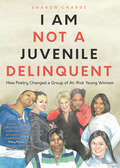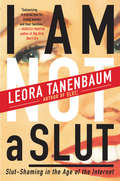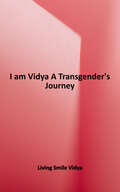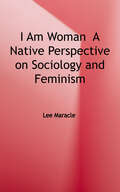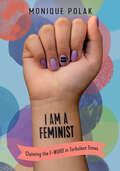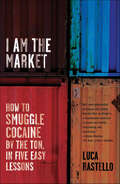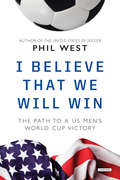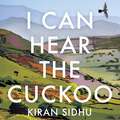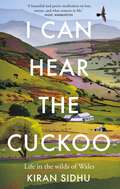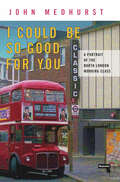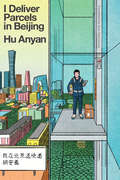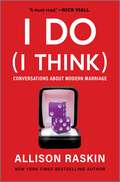- Table View
- List View
Hyperconsumption: Corporate Marketing vs. the Planet
by Gerard HastingsDiving deep into the world of corporate marketing, this incisive and eye-opening work shows how, in the hands of the corporation, business has become manipulative, divisive and disastrously at odds with the needs of the natural world. It calls on us to rethink and rebel. The corporate marketing blitz is driven by a simple economic truth: profits depend on demand always exceeding supply. A multi-billion-dollar global industry has therefore been created with the sole aim of turning us into devout consumers. Gerard Hastings invites us to explore alternatives to a system that is threatening our survival. He explores what it is to be human, how marketing can be used to do good rather than harm and the potential of alternative models that empower us to be citizens, not just consumers. Professionals and students in the business, marketing, public health, environmental and political sectors – as well as concerned citizens who know that business as usual is not an option – will value this accessible guide to what is going wrong with our current business models and how these failings can be addressed.
Hyperreality and Global Culture (Social Futures)
by Nicholas PerryThis book explores a world where the boundaries between reality and representation have become blurred, a world where LA Law is used to train lawyers. Drawing on examples from around the globe, Nick Perry presents a fascinating and entertaining analysis of both familiar objects and situations as well as the more unusual and absurd. Meals served in British pubs, motor-cycle gangs in downtown Tokyo, Australian movies, are just some examples used by the author in his engaging exploration of modern sense of the 'unreal'. Hyperrealities also engages with well known theorists of contemporary culture, from Baudrillard and Umberto Eco to Jameson and Sartre.
Hyperrealität und Transhumanismus: Der Mensch in der simulierten Gesellschaft (BestMasters)
by Mirco SpiegelDigitale Technologien sind heute ein fester Bestandteil des Alltags. Der Mensch wird zunehmend selbst zu einem Teil dieses Netzwerks aus Maschinen. Der französische Soziologe Jean Baudrillard beschreibt bereits vor mehreren Jahrzehnten eine solche Welt, in der sich Realität und Fiktion nicht länger unterscheiden lassen. Sie verschmelzen untrennbar zu einer neuen Realität, einer Hyperrealität, in der jeglicher Bezug zu den eigentlichen Phänomenen verloren gegangen ist. Der Transhumanismus hat die Verbesserung des Menschen durch Technologien im Fokus. Durch die Verbindung des biologischen Körpers mit Maschinen sollen die natürlichen Grenzen seiner physischen und mentalen Leistungsfähigkeit überwunden werden. Der Mensch soll seine Evolution aktiv gestalten, um sich letztendlich zu einem posthumanen Wesen zu entwickeln. Dieser Fortschritt erscheint nötig, um nicht durch Maschinen ersetzt zu werden. Auf den ersten Blick wirken viele Ideen zu Cyborgs und Künstlicher Intelligenz wie Science-Fiction Vorstellungen. Jean Baudrillard greift Bilder dieser Art auf und illustriert an ihnen, wie die Welt bereits ist. Eine fiktive Welt, die zur Wirklichkeit wird – Mirco Spiegel untersucht in diesem Buch, ob Visionen des Transhumanismus ein Teil davon sind.
Hyperspectral Remote Sensing of Nearshore Water Quality
by Sima BagheriThis book provides details on of the utility of hyperspectral remote sensing - NASA/AVIRIS in nearshore water quality issues of NY/NJ. It demonstrates the use of bio optical modeling and retrieval techniques to derive the concentrations of important water quality parameters (chlorophyll, color dissolved organic matter and suspended sediments) in the study area. The case study focuses on the nearshore waters of NY/NJ considered as a valued ecological, economic and recreational resource within the New York metropolitan area. During field campaigns (1998-2001) measurements were made to establish hydrological optical properties of the NY/NJ nearshore waters with concurrent NASA/AVIRIS overflights. The field measurements included: 1) concurrent above and below surface spectral reflectance; 2) shipboard sampling for determination of inherent optical properties (IOP); and 3) concentrations of optically important water quality parameters. Understanding the relationship between reflectance, absorption and scattering is essential for developing the analytical algorithm necessary to use remote sensing as a monitoring /management tool in the nearshore environment.
Hysteria: Crime, Media, and Politics
by Marc SchuilenburgAccording to the medical world, hysteria is a thing of the past, an outdated diagnosis that has disappeared for good. This book argues that hysteria is in fact alive and well. Hyperventilating, we rush from one incident into the next – there is hardly time for a breather. From the worldwide run on toilet paper to cope with coronavirus fears to the overheated discussions about immigration and overwrought reactions to the levels of crime and disorder around us, we live in a culture of hysteria. While hysteria is typically discussed in emotional terms – as an obstacle to be overcome – it nevertheless has very real consequences in everyday life. Irritating though this may be, hysteria needs to be taken seriously, for what it tells us about our society and way of life. That is why Marc Schuilenburg examines what hysteria is and why it is fuelled by a culture that not only abuses, but also encourages and rewards it. Written in a clear and direct style, this book will appeal to students and scholars of sociology, criminology, philosophy and all those interested in hysteria and how it permeates late modern society.
Hysterical Methodologies in the Arts: Rising in Revolt
by Johanna BraunHysteria is alive and well in our present time and is apparently spreading contagiously: especially the second decade of the twenty-first century has displayed an ever-increasing interest in the term. A quick Google search opens the gates to sheer endless swathes of discussions on hysteria, covering almost every aspect of public discourses. The arts—as it is often in such cases—seem conspicuously involved in and engaged with this hysterical discourse. Surprisingly, while the strong academic interest in hysteria throughout the twentieth century and most prominently at the turn of the century is well known and much discussed, the study of how these discourses have continued well into twenty-first-century art practices, is largely pressing on a blind spot. It is the aim of this volume to illustrate how hysteria was already well established within the arts alongside and at times even separately from the much-covered medical studies, and reveal how those current artistic practices very much continue a century spanning cross-fertilization between hysteria and the arts.
Hässliche Wörter: Hatespeech als Prinzip der neuen Rechten
by Joachim ScharlothSeit dem Wiedererstarken rechter Parteien und Denkweisen erlebt Deutschland ein gesteigertes Maß an Ausgrenzung und gesellschaftlicher Polarisierung. Ihr Medium ist die Sprache, die Neurechte von der AfD bis hin zu Kommentatoren in den dunkelsten Ecken des Internet um ein schier unerschöpfliches Repertoire an Schimpfwörtern bereichert haben. Das Buch versammelt die häufigsten und abstrusesten Schmähwörter und gibt so einen zutiefst verstörenden Blick in die sprachlichen Abgründe neurechter Weltbilder. Es ist keine im Modus von Betroffenheit und Empörung vorgetragene Anklage gegen Hassrede, sondern eine akribische Sammlung von Schmähungen und Beleidigungen, die die neue Rechte als das entlarvt, was sie ist: eine extremistische Schmähgemeinschaft, die nicht nur Minderheiten und allem Fremden mit Hass und Hetze begegnet, sondern auch Deutschland, die Deutschen und die Institutionen der Bundesrepublik zutiefst verachtet.
Héroes de nuestro tiempo: 25 años de periodismo deportivo
by Santiago SegurolaUna antología imprescindible para todos los amantes del periodismo y del deporte. La épica en la sociedad contemporánea parece haberse refugiado en el mundo del deporte, repleto de héroes y villanos, de gestas y fracasos, de actos románticos y vilezas despreciables. Mitad teatro de los sueños, mitad negocio tan lucrativo como corrupto, el deporte ha encontrado algunos cronistas de excepción capaces de reflejar su grandeza y sus ocasionales miserias. La carrera de Santiago Segurola probablemente sea uno de los mejores ejemplos en lengua española de esa tradición. Esta antología, preparada por Pedro Cifuentes y Pablo Martínez, recoge 25 años de dedicación al periodismo deportivo, desde el Madrid de la Quinta hasta el Barça de Guardiola, que coinciden además con la edad de oro del deporte español y con las carreras de algunos de los más gran - des deportistas de la historia, Bolt, Phelps, Michael Johnson, Nadal, Messi, Hierro, Jordan, Xavi o Zidane.
Höhlenkompetenz: Evolutionäre Ressourcen der Pandemiegesellschaft. Ein empirischer Disput
by Jürgen GrimmDas Buch basiert auf Untersuchungen, die zwischen 2017 und 2020 mit 1632 österreichischen, deutschen und Studierenden anderer Nationen in Wien durchgeführt wurden. Die Teilnehmer und Teilnehmerinnen befanden sich während der Coronakrise teilweise in Quarantäne oder waren zumindest auf Online-Teaching und Home-Office angewiesen. Wie gehen junge Menschen mit Freiheitsbeschränkungen um? Was tun sie, um körperlich und geistig „gesund“ durch die Krise zu kommen? Neben konstruktiven Formen des Umgangs mit der Pandemie finden wir in der Gesellschaft und teilweise auch in einzelnen Menschen verschwörungstheoretische Gedankenkomplexe, die aggressive und destruktive Verhaltensweisen nahelegen. Diese Widersprüchlichkeit hängt mit unserer Urgeschichte zusammen: der Homo sapiens musste sich einesteils wilden Tieren stellen und andernteils in Kaltzeiten als einzigen Ausweg in Höhlen zurückziehen. Theoretisch begründet und empirisch überprüft werden höhlenbezogene Denkweisen und ihre Verbindung mit Mut und Durchhaltewillen, aber auch mit Verschwörungstheorien, politischer Entfremdung und Rechtsextremismus: Denkmuster aus paläohistorischer Zeit als Chance und Risiko in der Coronakrise.Zum Band erscheint eine CD: Höhlenkompetenz in 52 Übungen, auf der die Regeln zusammen mit einer eigenen Komposition von Havard Enstad eingesprochen wurden.
I AM MALALA - The Girl Who Stood Up for Education and was Shot by the Taliban
by Malala Yousafzai Christina LambI AM MALALA is the remarkable tale of a family uprooted by global terrorism, of the fight for girls' education, of a father who, himself a school owner, championed and encouraged his daughter to write and attend school, and of brave parents who have a fierce love for their daughter in a society that prizes sons.
I Am Malala: The Girl Who Stood Up For Education And Was Shot By The Taliban
by Malala Yousafzai Patricia McCormickNIMAC-sourced textbook
I Am Not a Juvenile Delinquent: How Poetry Changed a Group of At-Risk Young Women
by Sharon ChardeThe #metoo movement, particularly the horrific Larry Nasser abuse, shows with frightening clarity the vulnerability of young women to male predators; all the Touchtone girls I encountered suffered similar or worse fates. The book is a pilgrimage, a quest story, divided into five sections. Part I explores the authors first year at the facility, the difficulty and eventual success of establishing my group in such a chaotic and contradictory culture. It recreates their writing sessions, and features the vivid, dramatic personalities of the girls who participated as well as the steep learning curve on which she found herself daily. Part II moves swiftly through the trials and victories between the first and last years, and offers brief profiles of three of the residents who held special resonance to the author. During this time she published an award-winning anthology of poems by the girls, a NYC filmmaker created a documentary film, many readings and public performances took place and received several awards for the program. Part III tells of the joint venture with The Hotchkiss School, revealing the differences yet common ground between the two groups of girls.
I Am Not a Slut: Slut-Shaming in the Age of the Internet
by Leora TanenbaumThe author of the groundbreaking work Slut! explores the phenomenon of slut-shaming in the age of sexting, tweeting, and “liking.” She shows that the sexual double standard is more dangerous than ever before and offers wisdom and strategies for alleviating its destructive effects on young women’s lives.Young women are encouraged to express themselves sexually. Yet when they do, they are derided as “sluts.” Caught in a double bind of mixed sexual messages, young women are confused. To fulfill the contradictory roles of being sexy but not slutty, they create an “experienced” identity on social media-even if they are not sexually active—while ironically referring to themselves and their friends as “sluts.”But this strategy can become a weapon used against young women in the hands of peers who circulate rumors and innuendo—elevating age-old slut-shaming to deadly levels, with suicide among bullied teenage girls becoming increasingly common. Now, Leora Tanenbaum revisits her influential work on sexual stereotyping to offer fresh insight into the digital and face-to-face worlds contemporary young women inhabit. She shares her new research, involving interviews with a wide range of teenage girls and young women from a variety of backgrounds as well as parents, educators, and academics. Tanenbaum analyzes the coping mechanisms young women currently use and points them in a new direction to eradicate slut-shaming for good.
I Am Vidya: A Transgender's Journey
by Living Smile VidyaIdentities are not mere markers we are known by; they define as well as limit us. They can both confine or release a consciousness. I Am Vidya is the story of one such journey that of a declaration, of the claiming of an identity. It is an assertion of a consciousness that has suffered the agony of being trapped in a mold it does not belong to, a body it does not identify with. Vidya has lived through all the indignities forced upon a tirunangai, a transgender, by a society that divides and defines itself as men and women in terms of biology alone from being spurned by her family, to begging on the streets as a social outcast, from donning a woman's clothes to undergoing excruciating surgery to lose her 'manhood', from suffering emotional and physical harassment, to arriving at her true identity. A compelling narrative about a woman trapped within a man’s body, this is a story of extraordinary courage and perseverance. Key Features - A compelling first-person narrative of a transgender - True story - A necessary intervention a call for fulfilment of basic human rights - Inspiring story of struggle and perseverance.
I Am Woman: A Native Perspective on Sociology and Feminism
by Lee MaracleOne of the foremost Native writers in North America, Lee Maracle links her First Nations heritage with feminism in this visionary book. "Maracle has created a book of true wisdom, intense pride, sisterhood and love." -Milestones Review
I Am a Feminist: Claiming the F-Word in Turbulent Times (Orca Origins #1)
by Monique PolakWhat is feminism? Why does it still matter? What exactly does intersectionality mean? In order to answer these (and many other) questions, I Am a Feminist first examines the history of feminism and then addresses the issues girls and women continue to face today. The book also looks at the ways in which people, especially young people, are working together to create a world where gender equality is a reality, not a dream. The author shares stories about the courageous individuals who have made a difference in the lives of women and girls worldwide. From suffragists to the #MeToo movement, I Am a Feminist encourages readers to stand up and speak out for equality and justice.
I Am the Market: How to Smuggle Cocaine by the Ton, in Five Easy Lessons
by Luca RastelloA page-turning account of the international cocaine trade, presented as five lessons in how to move tons of the drug across bordersForget about cocaine concealed in false-bottomed suitcases or swallowed in ovules resistant to gastric juices. When entire national economies are kept afloat by the money from cocaine smuggling, the quantities these tactics represent are meaningless. When a commodity like cocaine becomes a mainstay of the international economy, grams and kilos are irrelevant. Because what is needed to sustain the market is cocaine by the ton.Tons of cocaine means ships, cargo planes, and containers: large, cumbersome, extremely tangible, and visible amounts of white powder. So how is all that merchandise moved through harbors and airports? How are customs offices deceived, fiscal checks eluded, police networks infiltrated, and documents prepared to disguise mountains of cocaine?It's done with coca made into cubes, dissolved in liquid, hidden in marble blocks or inside electric cables. With friends in the right places. With cocaine smuggled in cranes. With sniffer dogs supplied to the police, free of charge. With money in cash, always. And yes, with willing mules swallowing drugs. But they will be arrested, and that's part of the plan.Drawing from years of research and conversations with criminal sources and convicted drug smugglers, with new information on the techniques, methods, and strategies used, Luca Rastello brings us a devastating portrait of the international cocaine trade. Told from the perspective of the formidable entrepreneurs whose tactics evolve and adapt to keep pace with shifts in the global economy, I Am the Market is a masterful exposé of a world we thought we understood—until now.
I Believe That We Will Win: The Path To A U. S. Men's World Cup Victory
by Phil WestPerceptive and thorough, I Believe That We Will Win is the timely analysis of the state of American soccer Americans love to win. But when it comes to soccer, the world’s most popular sport, the US women’s team has delivered three World Cup victories in as many decades, while the men have not advanced past the quarter-finals in nearly ninety years. In October 2017, the US Men’s National Team (USMNT) startled fans by failing to qualify for the upcoming World Cup, an episode that led both USMNT head coach Bruce Arena and US Soccer Federation President Sunil Gulati to step down from their positions, and which launched a new era of reckoning for US Soccer as a whole. As the 2018 World Cup commences with the US sidelined, fans are becoming impatient: What will it take for the USMNT to finally rise to an elite level and bring home the FIFA World Cup Trophy? In I Believe That We Will Win, veteran soccer journalist Phil West delivers a compelling assessment of the history and future potential of American soccer on the international playing field. With insightful commentary and endless enthusiasm, West examines every aspect of the USMNT and their competition, detailing how the US returned to the World Cup in 1990 after forty years without qualifying, delving into the growing symbiotic relationship between the USMNT and Major League Soccer, and exploring how the US is cultivating young talent through MLS academies and the US Development Academy—and how Latino outreach initiatives, like the Sueno Alianza competition that brought Jonathan González to prominence, can be better integrated into US Soccer’s quest for talented players. Along the way, West touches on the controversial tenure of former coach Jürgen Klinsmann, the role of dual-national players, Christian Pulisic and the new wave of American players playing abroad, and other issues that have engaged American soccer fans in spirited debate. Punctuated with dozens of revealing interviews from players, coaches, and journalists, I Believe That We Will Win is both the definitive history of American World Cup play and an incisive and inspiring analysis of America’s potential to win big in the near future.
I Can Hear the Cuckoo: Life in the Wilds of Wales
by Kiran Sidhu"A beautiful and poetic meditation on loss, nature, and what matters in life." - Nigel WarburtonFrom the award-winning writer of The New Yorker short film, Heart ValleyKiran Sidhu never thought she could leave London, but when her mother passes away, she knows she has to walk out of her old life and leave her toxic family behind. She chooses fresh air, an auditorium of silence and the purity of the natural world - and soon arrives in Cellan, a small, remote village nestled in the Welsh valleys.At first, the barrenness and isolation is strange. But as the months wear on, Kiran starts to connect with the close-knit community she finds there; her neighbour Sarah, who shows her how to sledge when the winter snow arrives; Jane, a 70-year-old woman who lives at the top of a mountain with three dogs and four alpacas; and Wilf, the farmer who eats the same supper every day, and teaches Kiran that the cuckoo arrives in April and leaves in July. Tender, philosophical and moving, I Can Hear the Cuckoo is a story about redefining family, about rebirth and renewal, and respecting the rhythm and timing of the earth. It's a book about moving through grief and the people we find in the midst of our sadness - and what this small community in the Welsh countryside can teach us about life.(P)Octopus Publishing Group 2023
I Can Hear the Cuckoo: Life in the Wilds of Wales
by Kiran Sidhu"A beautiful and poetic meditation on loss, nature, and what matters in life." - Nigel WarburtonFrom the award-winning writer of The New Yorker short film, Heart ValleyKiran Sidhu never thought she could leave London, but when her mother passes away, she knows she has to walk out of her old life and leave her toxic family behind. She chooses fresh air, an auditorium of silence and the purity of the natural world - and soon arrives in Cellan, a small, remote village nestled in the Welsh valleys.At first, the barrenness and isolation is strange. But as the months wear on, Kiran starts to connect with the close-knit community she finds there; her neighbour Sarah, who shows her how to sledge when the winter snow arrives; Jane, a 70-year-old woman who lives at the top of a mountain with three dogs and four alpacas; and Wilf, the farmer who eats the same supper every day, and teaches Kiran that the cuckoo arrives in April and leaves in July. Tender, philosophical and moving, I Can Hear the Cuckoo is a story about redefining family, about rebirth and renewal, and respecting the rhythm and timing of the earth. It's a book about moving through grief and the people we find in the midst of our sadness - and what this small community in the Welsh countryside can teach us about life.
I Can Hear the Cuckoo: Life in the Wilds of Wales
by Kiran Sidhu"A beautiful and poetic meditation on loss, nature, and what matters in life." - Nigel WarburtonFrom the award-winning writer of The New Yorker short film, Heart ValleyKiran Sidhu never thought she could leave London, but when her mother passes away, she knows she has to walk out of her old life and leave her toxic family behind. She chooses fresh air, an auditorium of silence and the purity of the natural world - and soon arrives in Cellan, a small, remote village nestled in the Welsh valleys.At first, the barrenness and isolation is strange. But as the months wear on, Kiran starts to connect with the close-knit community she finds there; her neighbour Sarah, who shows her how to sledge when the winter snow arrives; Jane, a 70-year-old woman who lives at the top of a mountain with three dogs and four alpacas; and Wilf, the farmer who eats the same supper every day, and teaches Kiran that the cuckoo arrives in April and leaves in July. Tender, philosophical and moving, I Can Hear the Cuckoo is a story about redefining family, about rebirth and renewal, and respecting the rhythm and timing of the earth. It's a book about moving through grief and the people we find in the midst of our sadness - and what this small community in the Welsh countryside can teach us about life.
I Could Be So Good For You: A Portrait of the North London Working Class
by John MedhurstI Could Be So Good For You is a unique portrait of north London's working class from the 1950s to the 21st century, and how it lived, struggled, survived and sometimes thrived. <p><p> I Could Be So Good For You tackles head-on the pernicious and implicitly racist fiction that London, most especially north London, has no "real" working class in comparison to a more "authentic" working class in a place called "the North". In doing so it offers a history and a portrait of north London's working class from the 1950s to the 21st century, based on a wide and original range of sources including personal memoirs, autobiographies, collected oral histories and new interviews conducted by the author. The result is an important social history and a rich panorama of working-class life — its struggles, work, celebrations, events, triumphs, tragedies and the occasional nice little earner. For good or ill, from the start of post-war affluence in the 1950s to the economic crash of 2008, north London's working class had a life experience like almost no other part of the British working class, one not just of poverty, racism and exploitation, but also of bold new housing schemes in the heart of the city, of great opportunity and diversity and enjoyment. Its about time to tell that story.
I Deliver Parcels in Beijing
by Hu AnYan"Hu Anyan&’s I Deliver Parcels in Beijing, translated by Jack Hargreaves, offers an unvarnished dispatch from the front lines of the gig economy, written by a guy who&’s held nearly every low-wage, low-reward job on the market (delivery driver, security guard, convenience store clerk, bicycle salesman). The Cinderella bit of it is that now he can add a new title: internationally best-selling author." —Leah Greenblatt, The New York Times Book ReviewA runaway bestseller in China, sold in 17+ countries, this delightfully honest and humorous account gives a face and voice to the future of work—as if Nomadland met Nickel and Dimed. In 2023, I Deliver Parcels in Beijing became the literary sensation of the year in China. Hu Anyan&’s story, about short-term jobs in various anonymous megacities, hit a nerve with a generation of young people who feel at odds with an ever-growing pressure to perform and succeed.Hu started posting essays about his experiences online during COVID lockdowns. His recollection of night shifts in a huge logistics center in the south of China went viral: his nights were so hot that he could drink three liters of water without taking a toilet break; his days were spent searching for affordable rooms with proper air-conditioning; and his few moments of leisure were consumed by calculations of the amount of alcohol needed to sleep but not feel drowsy a few hours later.Hu Anyan tells us about brutal work, where there is no real future in sight. But Hu is armed with deadpan humor and a strong idea of self. He moves on when he feels stuck—from logistics in the south, to parcel delivery in Beijing, to other impossible jobs. Along the way, he turns to reading and writing for strength and companionship.I Deliver Parcels in Beijing is an honest and startling first-person portrait of Hu Anyan's struggle against the dehumanizing nature of our contemporary global work system—and his discovery of the power of sharing a story.
I Do (I Think): Conversations About Modern Marriage
by Allison Raskin"Marriage norms in today&’s society are rapidly changing and it can be hard to keep up. Allison Raskin&’s book unpacks the questions and uncertainties around marriage that so many of us have... a must-read for anyone and everyone that may be curious about the intricacies of modern marriage.&” –Nick Viall, TV Personality, Host of The Viall Files, and Bestselling AuthorFrom Just Between Us cohost and bestselling author Allison Raskin comes a witty, incisive take on modern marriage and how a new generation can navigate its uncertainties and questions.Marriage rates may be on the decline, but that doesn&’t mean marriage is disappearing from society. In fact, as modern relationship norms and structures continue to evolve, the public discourse about marriage has never been louder—or more conflicted. Divorce rates, the appeal of cohabitation, seemingly infinite options for future partners, the patriarchal roots of marriage and gender roles, and economic uncertainty are just a few factors that leave a new generation of single and dating adults wondering. What does marriage even look like now? Why do people still do it? And, most importantly, is it &“for me&”?With conversational wit and compassion, bestselling author Allison Raskin draws on new research, interviews with licensed experts, and the stories of real-life couples to break down the many pieces of today&’s &“marriage conversation&”—and to make the leap of faith a little less scary for Gen Z and millennial adults like herself. What emerges is a thoughtful investigation into our cultural assumptions about commitment, compatibility, divorce, meaningful partnership, the future of marriage—and what it really means to join your bank accounts.
I Do But I Don't: Why the Way We Marry Matters
by Kamy WicoffA modern womanOCOs look at what it means to be a bride-caught between feminist ideals and the allure of the traditional wedding"
